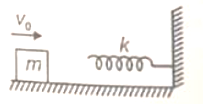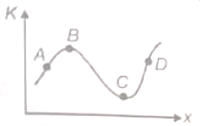A block of mass m moving with velocity v0 on a smooth horizontal surface hits the spring of constant k as shown. The maximum compression in spring is

1.
2.
3.
4.

For a particle moving under the action of a variable force, kinetic energy-position graph is given, then

1. At A particle is decelerating
2. At B particle is accelerating
3. At C particle has maximum velocity
4. At D particle has maximum acceleration
A particle moves with the velocity under the influence of a constant force, N. The instantaneous power applied is
1. 5 W
2. 10 W
3. 20 W
4. 30 W
A body is projected from ground obliquely. During downward motion, power delivered by gravity to it
1. Increases
2. Decreases
3. Remains constant
4. First decreases and then becomes constant
A body of mass m accelerates uniformly from rest to velocity v1 in time interval T1. The instantaneous power delivered to the body as a function of time t is
1.
2.
3.
4.
The power of a pump, which can pump 500 kg of water to height 100 m in 10 s is
1. 75 kW
2. 25 kW
3. 50 kW
4. 500 kW
A U-238 nucleus originally at rest, decays by emitting an -particle, say with a velocity of v m/s. The recoil velocity (in ms-1) of the residual nucleus is
1.
2.
3.
4.
An object of mass 80 kg moving with velocity 2 ms-1 hit by collides with another object of mass 20 kg moving with velocity 4 ms-1. Find the loss of energy assuming a perfectly inelastic collision
1. 12 J
2. 24 J
3. 30 J
4. 32 J
Particle A makes a perfectly elastic collision with another particle B at rest. They fly apart in opposite directions with equal speeds. If their masses are mA and mB respectively, then
1. 2mA = mB
2. 3mA = mB
3. 4mA = mB
4. mA = mB
A body of mass 10 kg moving with speed of 3 ms-1 collides with another stationary body of mass 5 kg. As a result, the two bodies stick together. The KE of composite mass will be
1. 30 J
2. 60 J
3. 90 J
4. 120 J






